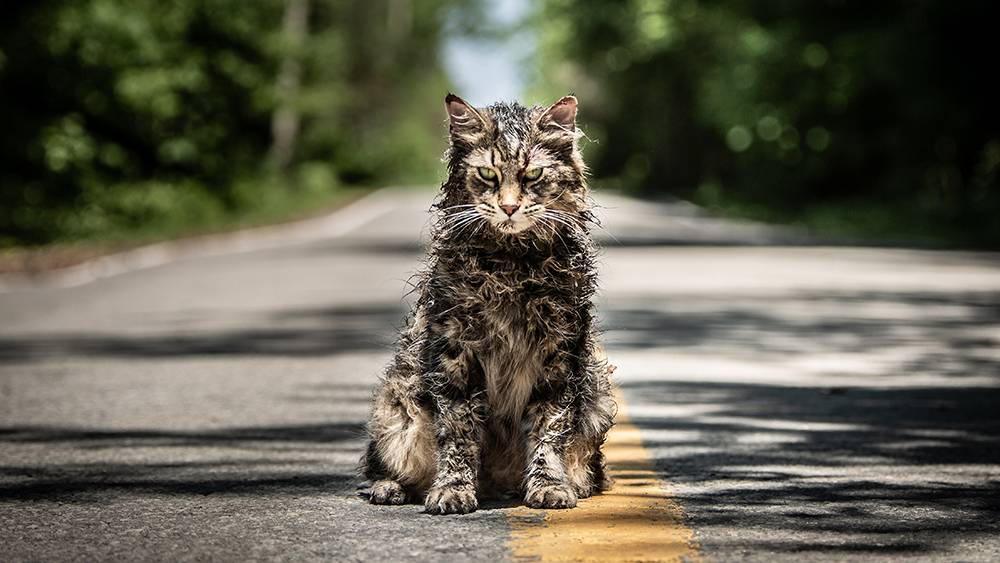Movie Review: “Pet Sematary” (R)
![]() “Pet Sematary” is one of Stephen’s King’s most celebrated novels. And in fact, it was once famously turned into a hit movie three decades ago. Still, that hasn’t stopped Paramount Pictures from double-dipping and delivering another big-screen adaptation of this much cherished property. And while there is plenty to squirm at in this updating — even King himself proclaims to be fan — it takes a while for this “Pet Sematary” to find its groove.
“Pet Sematary” is one of Stephen’s King’s most celebrated novels. And in fact, it was once famously turned into a hit movie three decades ago. Still, that hasn’t stopped Paramount Pictures from double-dipping and delivering another big-screen adaptation of this much cherished property. And while there is plenty to squirm at in this updating — even King himself proclaims to be fan — it takes a while for this “Pet Sematary” to find its groove.
In “Pet Sematary,” the Creed family must adjust to a new life after moving from Boston to rural Maine, and for the early goings, the good doctor Louis (Jason Clarke), his wife Rachel (Amy Seimetz), and their two children Ellie (Jete Laurence) and Gage (Hugo and Lucas Lavoie) do just that. Unfortunately, a tragedy involving the family cat, Church, and a bit of apparent folklore unveiled by loner neighbor Jud (John Lithgow) eventually bring the Creeds face to face with complete and utter evil, and it all lies at the center of a mystical burial ground just beyond the Pet Sematary.
 Aside from a nifty little twist that’s all but spoiled in the film’s revealing trailer, the first 60 minutes or so of this “Pet Sematary” retelling follow the beats of both Mary Lambert’s 1989 movie version and the iconic source material that inspired it. But then directors Kevin Kolsch and Dennis Widmyer (“Starry Eyes) wisely stray from the beaten path by way of an eerie and uncomfortable final act. It’s all punctuated by a bleak ending that brings to mind elements of Jordan Peele’s recent hit, “Us.” Of course, this isn’t the first time a film has actually improved upon a King novel ending courtesy of a sucker punch to the gut. Frank Darabont pulled off a similar feat with the devastating final moments of the underappreciated “The Mist.”
Aside from a nifty little twist that’s all but spoiled in the film’s revealing trailer, the first 60 minutes or so of this “Pet Sematary” retelling follow the beats of both Mary Lambert’s 1989 movie version and the iconic source material that inspired it. But then directors Kevin Kolsch and Dennis Widmyer (“Starry Eyes) wisely stray from the beaten path by way of an eerie and uncomfortable final act. It’s all punctuated by a bleak ending that brings to mind elements of Jordan Peele’s recent hit, “Us.” Of course, this isn’t the first time a film has actually improved upon a King novel ending courtesy of a sucker punch to the gut. Frank Darabont pulled off a similar feat with the devastating final moments of the underappreciated “The Mist.”
As solid and downright eerie as much of the final act is, there are plenty of elements in the first hour that simply don’t work. High among them is a funeral procession made up of little kids wearing creepy animal masks as they make their way to the cemetery to bury their beloved pets. This particular sequence feels labored, out of place, and lacking in any organic sense of purpose. Worse still, this brief scene suggests that perhaps it will come into play in some way later on the film. It doesn’t.
Beyond that, there are plenty of plot beats throughout this picture that feel all too mechanical and almost nonsensical in nature, be it a brief afterlife debate between Louis and Rachel (the film oddly seems to suggest that the couple have never had this argument before, even though they’ve been married for quite some time) or the very idea that Jud would dare suggest that Louis bury Church beyond the Pet Sematary, even though he had a very bad experience doing that very thing with his own four-legged friend years earlier.
Elsewhere, a subplot involving a ghostly shooting victim named Victor Pascow isn’t as interesting here as it was in Lambert’s version. Likewise, a backstory involving Rachel’s sickly, contorting sister Zelda almost feels shoehorned into this picture. Both of these subplots are designed to tap into the film’s themes of guilt, regret, and grief, but as is the case with a lot of the happenings in the first hour, patience feels scarce. Similar themes of guilt, regret, and grief worked to much stronger affect in Ari Aster’s polarizing horror hit, “Hereditary.”
In addition to a solid final act, kudos are in order for expert casting here. Clarke brings a quiet intensity to Louis. When forced with a daunting choice, he wastes very little time in making a very impulsive decision, and even though it’s clearly a poor choice, Clarke makes you understand why he might make such a decision. Seimetz is equally effective as a mother who is forced to deal with a parent’s worst nightmare, one that is only compounded by decisions made late in the picture. The Lavoie twins are fine here as little Gage, although it should be noted that they aren’t asked to go to the same disturbing lengths that young Miko Hughes went to in the 1989 version.
This brings us to a mesmerizing Laurence who absolutely kills it as Ellie, particularly in the final act! I’ll tread lightly here as to preserve some of the surprises and will only say that the bathtub scene really got under my skin. That thing she does with her eye might lead one to believe that perhaps she’s a distant relative of Pennywise.
Of the cast, only John Lithgow disappoints, but that’s only because he’s been left with the daunting challenge of matching the warmth and personality of Fred Gwynne. To Lithgow’s great credit, he doesn’t try and compete. Instead of going the jovial route, Lithgow plays Jud as a bit of a quiet and lonely creeper type, to mixed effect. Putting it in the simplest of terms, sometimes Herman Munster is better.
It’s clear that this “Pet Sematary” suffers from a clunky exposition and an overall rushed nature, but it certainly gets mileage out of an unsettling tone, a moody atmosphere, a solid Christopher Young score, and a very capable cast. And again, that final act! Honestly, I’d say this movie is worth watching for the liberties taken in the home stretch alone.
Articles related to “Movie Review: ‘Pet Sematary’ benefits from a few welcome alterations, particularly in the final act”
Movie Review: “Captain Marvel” is on the lower end of the Marvel-movie spectrum
Movie Review: “Us” suggests we are our own worst enemy in delightfully freaky fashion




